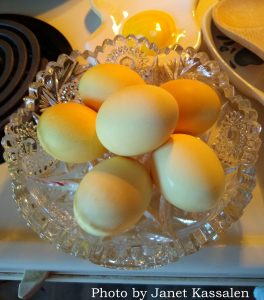Coloring hard cooked eggs at Easter time was a tradition which started in my childhood and has lasted throughout my adulthood. When I was growing up, I remember Mom using her meat roaster, an oval shaped blue enamel pan with a matching lid, in which to cook a dozen or two eggs. She would always cook a couple of extra eggs in case any eggs cracked during the cooking process. That would ensure we would end up with a complete dozen of perfect eggs, without cracks, per carton. Mom would let the raw eggs set out of the refrigerator till they got closer to room temperature before cooking them. She would carefully place each egg in the pan, add enough cold water to submerge them, turn the gas burner up high, and heat the water in the pan till it started to boil. Then she would turn the flame down in order to let the water come to a simmer. At that point, Mom would set her hand cranked white timer, with painted black numbers (5,10, 15, . . . 55) and markings for each of the minutes, for 17 minutes. The timer made a tick-tocking noise as the face of it slowly moved counter-clockwise. It would give one solid “ding!” signaling when the 17 minutes were up. Then the pan and eggs could be set in the kitchen sink where cold running water from the sink faucet could cool the eggs. Mom would put 2 teaspoons of vinegar and half cup of boiling water in each of six coffee cups to which my sisters and I would plunk one tablet of each of the different colors which came in an egg coloring packet kit. The kit also came with a copper wire egg holder which had a hexagonal shaped base the right size for holding one egg. We girls had fun watching the tablets fizz till they were completely dissolved, turning the water into a crisp blue, violet, pink, green, yellow and orange color. We preferred using spoons to dunk our eggs. We would let the egg in the shell sit at the bottom of the coffee cup completely submerged, lifting it up with a spoon occasionally to reposition the egg in order to ensure the complete surface of the egg would end up being colored. The longer you leave the eggs in the coloring, the deeper the color the egg shell would become. Mom always said, “Be sure to make a royal blue one!” After we took each egg out of the coloring with a spoon, we would place it on newspaper or a paper towel and let it dry. Sometimes, after an egg would dry, one of us girls would dunk just part of the egg in a second or third color. (We got a little creative.) I usually ended up staining the tips of at least some of my fingers. (If that happens to you, it’s best to dry your fingers well with a paper towel, so you don’t get fingerprints on another egg.)
One can use regular food coloring to color eggs. Just use a couple of drops in each coffee mug with water and vinegar. Also, one can make golden colored eggs by adding onion skins in the water of your pan when cooking your eggs.  I tried this technique out yesterday; it worked pretty well. One can research the history of egg coloring on the internet to find out more fun facts and ideas.
I tried this technique out yesterday; it worked pretty well. One can research the history of egg coloring on the internet to find out more fun facts and ideas.
I hope you can find time to color your own eggs this Easter time if this is a tradition at your household. If you want to, you can use construction paper, computer paper and crayons, or other things you might be able to find around the house, to come up with your own kind of eggs. Be creative. Have fun!
